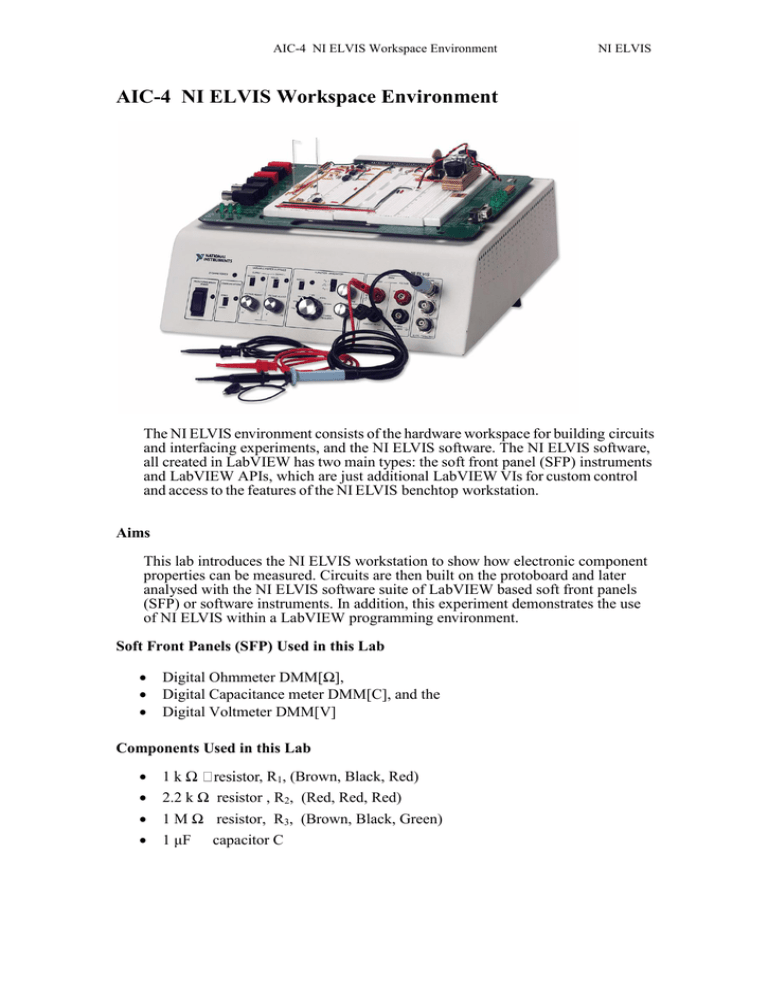AIC-4 NI ELVIS Workspace Environment
advertisement

AIC-4 NI ELVIS Workspace Environment NI ELVIS AIC-4 NI ELVIS Workspace Environment The NI ELVIS environment consists of the hardware workspace for building circuits and interfacing experiments, and the NI ELVIS software. The NI ELVIS software, all created in LabVIEW has two main types: the soft front panel (SFP) instruments and LabVIEW APIs, which are just additional LabVIEW VIs for custom control and access to the features of the NI ELVIS benchtop workstation. Aims This lab introduces the NI ELVIS workstation to show how electronic component properties can be measured. Circuits are then built on the protoboard and later analysed with the NI ELVIS software suite of LabVIEW based soft front panels (SFP) or software instruments. In addition, this experiment demonstrates the use of NI ELVIS within a LabVIEW programming environment. Soft Front Panels (SFP) Used in this Lab Digital Ohmmeter DMM[Ω], Digital Capacitance meter DMM[C], and the Digital Voltmeter DMM[V] Components Used in this Lab 1 , R1, (Brown, Black, Red) 2.2 k Ω resistor , R2, (Red, Red, Red) 1 M Ω resistor, R3, (Brown, Black, Green) 1 μF capacitor C AIC-4 NI ELVIS Workspace Environment NI ELVIS Exercise 4-1 Measurement of Component Values Connect two banana type leads to the DMM current inputs on the workstation front panel. Connect the other ends to one of the resistors. Launch NI ELVIS. After initializing, the suite of LabVIEW software instruments pops up on the computer screen. Select Digital Multimeter. The Digital Multimeter SFP (Soft Front Panel) can be used for a variety of operations. We will use the notation DMM[X] to signify the X operation. Click on the Ohm button [Ω] to use the Digital Ohmmeter function DMM[Ω]. Measure R1, R2, and R3. Using the capacitor button [-| |-], measure the capacitor C with DMM[C] using the same leads. Fill in the following table. R1 _________ Ω (1.0 k nominal) R2 _________ Ω (2.2 k nominal) R3 _________ Ω (1.0 M nominal) C __________ μF (1.0 μF nominal) Note If you are using an electrolytic capacitor be sure to connect the + lead of the capacitor to the DMM current +input and click on the electrolytic button of the DMM[C]. End of Exercise 4-1 AIC-4 NI ELVIS Workspace Environment Exercise 4-2 Protoboard NI ELVIS Building a Voltage Divider Circuit on the NI ELVIS 1. Using the two resistors, R1 and R2, assemble the following circuit on the NI ELVIS protoboard. 2. The input voltage Vo is connected to the [+5 V] pin socket and the common to the NI ELVIS [Ground] pin socket. R1 V0 3. Connect the external leads to the DMM voltage inputs (HI) and (LO) on the front panel of the NI ELVIS workstation. R2 V1 4. Check your circuit and then apply power to the protoboard by switching the Prototyping Board Power switch to the upper position. The three power indicator LEDs +15V, –15V, and +5V should now be lit. 5. Connect the DMM front panel leads to Vo and measure the input voltage using the DMM[V]. 6. Circuit theory tells us that the output voltage V1 should be R2/(R1+R2) * V. Using the previous measured values for R1, R2, and Vo, calculate V1. Then, use the DMM[V] to measure the actual voltage V1. V1 (calculated) V1 (measured) How well does the measured value agree with your calculated value? End of Exercise 4-2 AIC-4 NI ELVIS Workspace Environment NI ELVIS Exercise 4-3 Using the DMM to Measure Current From Ohms law, the current I flowing in the above circuit is equal to V1/R2. With the measured values of V1 and R2, calculate this current. Next, do a direct measurement. Do this by moving the external leads to the workstation front panel DMM (Current) inputs HI and LO. Connect the other ends to the circuit as shown below. Select the function DMM[A–] and measure the current. I (calculated) __________ I (measured) __________ How well does the measured value agree with your calculated value? End of Exercise 4-3 Exercise 4-4 Observing the Voltage Development of a RC Transient Circuit Build the RC transient circuit as shown below. It uses the voltage divider circuit where R1 is now replaced with R3 (1 MΩ resistor) and R2 is replaced with the 1μF capacitor C. Move your front panel leads back to the DMM(VOLTAGE) inputs and select DMM[V]. When you power up the circuit, the voltage across the capacitor will rise exponentially. Turn on the power and watch the voltage change on the DMM display. It takes about 5 seconds to reach the steady state value of Vo. When you power off the circuit, the voltage across the capacitor will fall exponentially to 0 volts. Try it! It would be interesting to view this transient effect on a plot of capacitor voltage versus time. End of Exercise 4-4 AIC-4 NI ELVIS Workspace Environment Exercise 4-5 NI ELVIS Visualizing the RC Transient Circuit Voltage 1. Remove the + 5V power lead and replace it with a wire connected to the Variable Power Supply socket pin VPS[+]. Connect the output voltage, V1, to ACH0[+] and ACH0[–]. 2. Close the NI ELVIS software suite and launch LabVIEW. 3. From the Hands-On NI ELVIS VI Library, select RC Transient.vi. This program uses LabVIEW APIs to turn the power supply ON for 5 seconds then OFF for 5 seconds while the voltage across the capacitor is displayed on a LabVIEW chart. This type of square wave excitation dramatically shows the charging and discharging characteristics of a simple RC circuit. The circuit time constant is defined as the product of R3 and C. From Kirchoff’s laws it is easy to show that the charging voltage VC across the capacitor is given by: VC = V0 (1-exp(- t/)) and the discharge voltage VD is given by: VD = V0 exp(- t/) Can you extract the time constant from the measured chart? Take a look at the LabVIEW diagram window to see how this program works. End of Exercise 4-5 Reference: Prof. Barry Paton, Introduction to NI ELVISTM, http://www.ni.com/example/29852/en/
